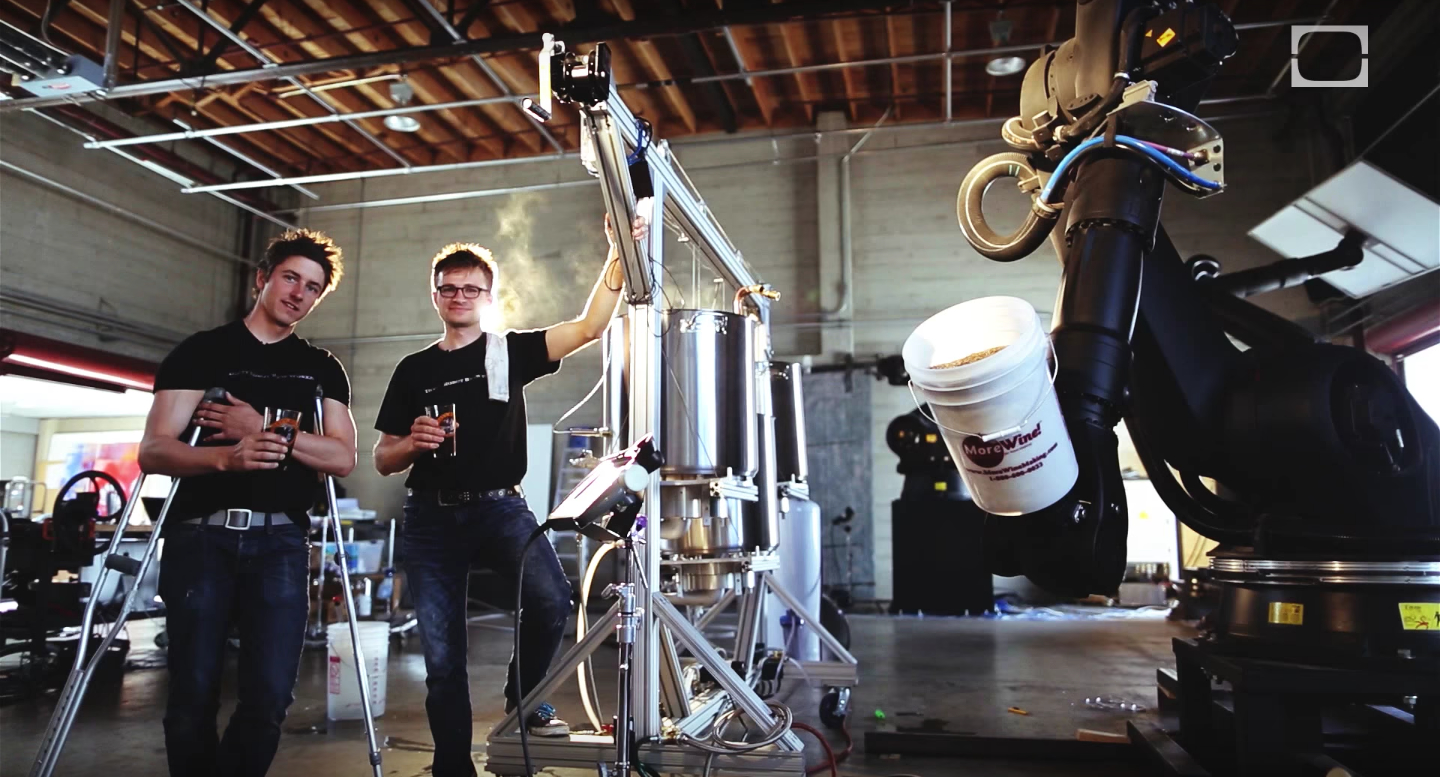
Robohub.org
Five applications for craft beer robots
What tasks in a craft brewery can you do with a collaborative robot? Here are five options to improve the efficiency, consistency and safety of manufacturing in the beverage industry.
In a previous post, we showed how craft brewers can benefit from collaborative robots (aka cobots). These new robots can help to overcome the challenge of scaling up a brewery, without compromising the integrity of the beer. They work alongside you and don’t need safety fences.
But, which tasks should you give to a craft brewing cobot? Here are five great applications to get you started. These applications are also relevant to other beverage manufacturers, so read on even if you’re not a brewer.
Application 1: Packaging
Packaging beer is a perfect task for a cobot. Simple packaging applications only require a robot and an off-the-shelf gripper (you may have to make a custom fingertip to hold your bottles or cans).
In this video you can see a demo of a FANUC LR MATE 200iD robot packing beer. It was developed by students and it could be improved quite a lot (e.g. better part presentation than their mock conveyor-belt and a more effective glueing method), but you get the idea.
- It is a non-value added task. In no way does it affect the quality of the beer.
- It involves repetitive, physical movements so there is a risk of repetitive strain injury (RSI).
- It is boring, tiring and wastes time you could use for more important tasks (you’ll know what I’m talking about if you’ve ever lost the best part of a day packing 4000 bottles into boxes).
Programming this type of task is really simple. In fact, I would be willing to bet that a 13-year-old could program it.
If you wanted a more advanced packing application, you could easily add some extra parts to make it even quicker, like in this video:
By the way, the reason that the robot is inside a glass case is that the LR MATE is not a collaborative robot. However, there is a collaborative version of it: the FANUC CR-7iA, which was released earlier this year. It’s exactly the same robot, but with added safety features so you can use it without a safety fence.
Application 2: Palletizing and depalletizing
These days, most things are shipped on pallets. Palletizing involves arranging items onto a pallet; depalletizing involves taking items off. This is a very popular task for brewery robots, for the same reasons that we listed above.
Programming a collaborative robot to do these tasks is really easy when you use a palletizing wizard. Palletizing in breweries often involves lifting heavy objects, which is also possible with modern collaborative robots.
Heavy Lifting with Collaborative Robots
Heavy lifting? Collaborative robots? You’re joking, right? … Nope.
A lot of brewery tasks involve heavy lifting: moving beer kegs, lifting boxes, dragging bags of grain, etc. These tasks are not just hard work, they are actually dangerous. Repeated heavy lifting can lead to musculoskeletal disorders, which account for 35% of the work days lost to injury.
If you had asked me this time last year, I would have said that collaborative robots can’t do heavy lifting (most have a payload capacity of around 5-10kg). That all changed this year. Collaborative robots are starting to appear with some impressive lifting capability. For example, Comau’s AURA robot can lift up to 110kg.
Here are the weights of common brewery objects. I have included examples of collaborative robots which can lift these weights and are available this year:
| Object | Approx Weight | Example Cobot | Payload Capacity |
| 12oz beer can | 360g | YuMi | 0.5kg |
| 12oz beer bottle | 450g | Baxter | 2.2kg |
| 750ml beer bottle | 1.5kg | UR3 | 3kg |
| Box of 24 x 12oz cans | 9kg | UR10 | 10kg |
| Case of 24 x 12oz bottles | 16kg | CR-35iA | 35kg |
| 50lb sack of malt | 25kg (inc. sack) | CR-35iA | 35kg |
| Homebrew beer keg (empty) | 3.8kg | UR5 | 5kg |
| Homebrew beer keg (full) | 26kg | CR-35iA | 35kg |
| Full U.S. beer keg (empty) | 13.5kg | CR-35iA | 35kg |
| Full U.S. beer keg (full) | 72.8kg | AURA | 110kg |
For most small tasks in your brewery, you will need a normal sized collaborative robot, of around 10kg payload. There are many collaborative robots within this range. However, if you want to use robots for heavy lifting, it is now an option.
If you need to go even heavier — and you have some extra space to spare — you could also go for a high-payload, traditional robot inside a secure area.
Application 3: Bottle capping
Manual bottle capping is an arduous task. Even if you are using a bench capper, your arm will get very tired after a few hundred bottles. That means a high risk of musculoskeletal disorders. It also means that the muscles of your capping arm are much stronger than the other one, which is never good.
Automatic, or semi-automatic, bottle capping machines are quite common in the industry. Nobody but the most hard-line artisan brewer will think less of you for using one.
The problem with the semi-automatic machines is that you still waste time loading and unloading the bottles. This is the perfect job for a collaborative robot!
Imagine a robot loading the semi-automatic bottle capper in this video, using a dual gripper configuration like the one shown to hold two bottles at once:
Application 4: Labeling
Labeling is a similar application to bottle capping because you would use an automatic labeling machine to do it with a robot. We’ve already seen companies using collaborative robots for this type of task, like Australian manufacturer Prysm Industries who used a UR5 to label plastic tubs.
Many craft breweries already use these automatic labeling machines. One popular type looks a bit like a desktop printer — you just place the bottle and press a big button to apply the label. If you already use this type of machine, you won’t need to change it when you introduce the robot. We often recommend that you use existing interfaces for this type of task: simply program the robot to press the button.
Application 5: Serving beer
Okay, so maybe you don’t serve much beer in your brewery (or maybe you do). We just had to include this application because we love beer serving robots here at Robotiq. Two of our highlights this year came from our visit to the Automatica 2016 trade fair:
Two robots were cooking sausages and pouring beer at the SAR Elektronic booth.
KUKA were using a beer pouring robot bartender at their booth.
We learned one thing from these demos: beer serving robots really draw a crowd!
tags: c-Industrial-Automation, cobots, collaborative robotics, robotics, robotiq







